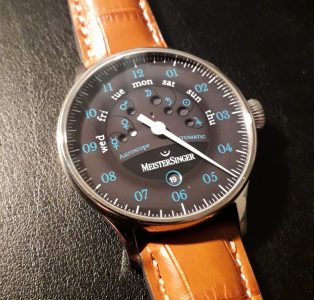I probably came across MeisterSinger some five years ago when my consumption of watch material increased. To be frank, I was not that interested as I found the one-handed aspect bit of a gimmick. How could one possibly tell the time properly? So, I dismissed the watches as somewhat of an irrelevance. This was until a Watchmakers Club event a couple of years ago when I first met their UK agent, Monica Porracin, an enthusiastic Italian based in London. I would have been drifting past her stand on an initial recce, and for the ones I was not overly interested in, adopting my usual ploy of speeding up whilst also attempting not to meet the eyes of their hosts. I was trying to do the same with Monica, but she was having none of it. “Hello, are you familiar with MeisterSinger” – or words to that effect. I think I mumbled slightly negatively, hoping my curmudgeonly reaction would deter further interaction. It was not to be as I had hesitated too long, and the chink in my armour had been exposed! So, in the end we spent a pleasant enough 20 minutes or so chatting and I took some photos of a few interesting and attractive pieces I had identified. Cards were exchanged.
I was now on Monica’s contact list so received periodic updates on MeisterSinger pieces, along with her other brands such as Muhle and Doxa). Thus my education increased! Then the Covid lock-down struck! My usual sources of hands-on watches (independent retailers, brand boutiques and shows) ceased in an instant. True, I had some material banked and sufficient for a few articles, but after a month or so this dried up so was forced into writing about some of my own watches. I think and hope this transpired to be reasonably interesting, but of course was not really the point of the website. Anyway, in the end, even my excessive collection had its limits! So, I decided to bite the bullet and attempt to reach out to brands/agents to see if they would send me some watches. Clearly, they would have to trust me enough to firstly write sensible reviews, and secondly not damage their stock or worse waltz off with it! Logically of course, the first targets would be people I actually knew. From my first salvo the first to reply (within 15 minutes – what service) was Monica who, after some discussion, was happy to send me something. At this juncture I pointed out that ideally I needed to select, as one of my tenets is to only review pieces I like the look of! She agreed with this sentiment and promised to check her stock of items that could meet my parameters. Shortly thereafter I heard from Monica again, and decided to opt for the Astroscope as it had some interesting complications and this version was quite new. Also, I could really check out this one-handed business! Incidentally, in the end I also selected another piece from Monica’s stable – a Muhle item, and that will shortly appear in print.
For those not particularly au-fait with MeisterSinger, the company is comparatively new, being started in 2001 by one Manfred Brassler. They are based in Munster, Germany and the name comes from the medieval groups that came from several old German cities and competed for excellence in singing. From the get-go, the plan was to make something quite different to the norm, in that the watches would only have one hand – to both read hours and minutes. Their website notes that the inspiration came from early clocks, where only one hand was present. This may simply have been because the mechanical complexities of using two hands had not yet been discovered, or overcome, or just deemed unnecessary. Anyway, MeisterSinger decided to adopt this unusual feature in their watches in homage to olden times, and up to a point for simplicity’s sake. The fact that nobody else was really doing this was also probably a good marketing angle for a new brand, but also a little risky I would say. Their logo – the fermata symbol (like a one-eyed smiley) is a music notation that indicates a pause. I suppose when you look at a watch and the hand, it is like a snapshot or pause in time. However, alas, that is a mere illusion as time never truly stops!
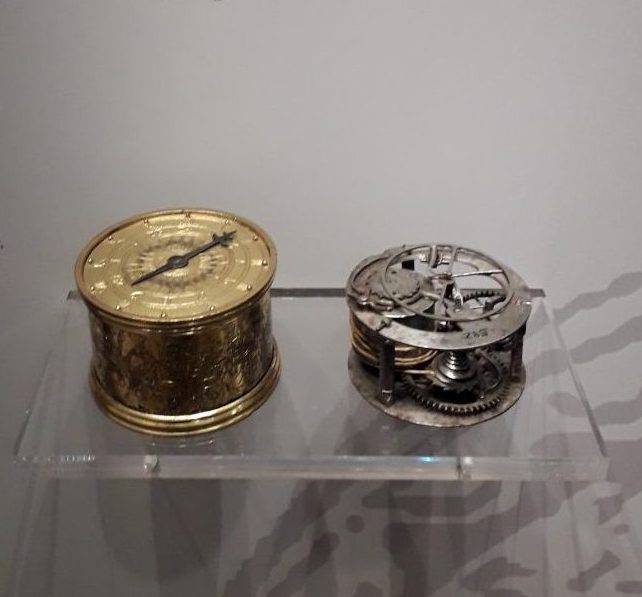
Today the company has a fair range of models, most being everyday or even dress types. Many are time or time/date only, but some have extra and interesting complications. The general style is round-cased and in steel. Some look quite modern whilst others seem quite vintage. Movements are generally Swiss and in common usage, but modified as appropriate, along with some other components – hence the “Swiss Made” on the cases. The watches are therefore affordable, generally ranging from around £1,000 – £2,500.
At this juncture I thought it useful just to explore the one-handed concept and moreover its relevance and practicality. As mentioned earlier I had dismissed this really. Why go back in time and use a display method that has now been superseded – presumably for good reason? Anyway, I have been keen to investigate this for some time and now can.
When I look at my “normal” watch, I realise I do not actually look at each hand individually to tell the time. I actually look at the watch center, but seem to be able to instantly note the exact time in hours and minutes. Now, is that due to what I actually see (and process very quickly), or is it simply almost sub-conscious with the conditioning of many years of being used to two hands. I suspect that there is an element of both here, but there is no doubt to me that with two hands the information they impart has more instant clarity and thus quickly assimilated. Turning to one hand pieces, the reading of this is different. In this case (I am looking at the watch now), I do have to study the one hand in two stages. The first is to ascertain the hour, then the second the minutes. However, to do the latter you have to peer a little harder to see exactly where the thin pointer end is on the minute track. In reality, if one wants a quick reading one just has to estimate the minutes – unless you pause and peer more intently! In this regard, it is therefore preferable that the whole dial with it’s contained numerals, track and pointer, are as clear as possible. Whilst my experiment is no scientific tour-de-force (I am not sure it needs to be really), to my mind, a single handed watch – at least initially, may not give the wearer as quick and accurate a reading as a two handed version, but with familiarity, it may come close. So, that is not to say that single-handers have no real place today – as has been proven by MeisterSinger’s success. Indeed they seem to acknowledge the differences of a single-hander over a two-hander – but that is their raison d’être! Some collectors may just want an alternative type of watch to the norm, and therefore be quite happy with any nuances , which in the overall scheme of things will be slight. In addition of course there is the actual design and complication attractions. In fact, MeisterSinger have some very attractive and interesting models.
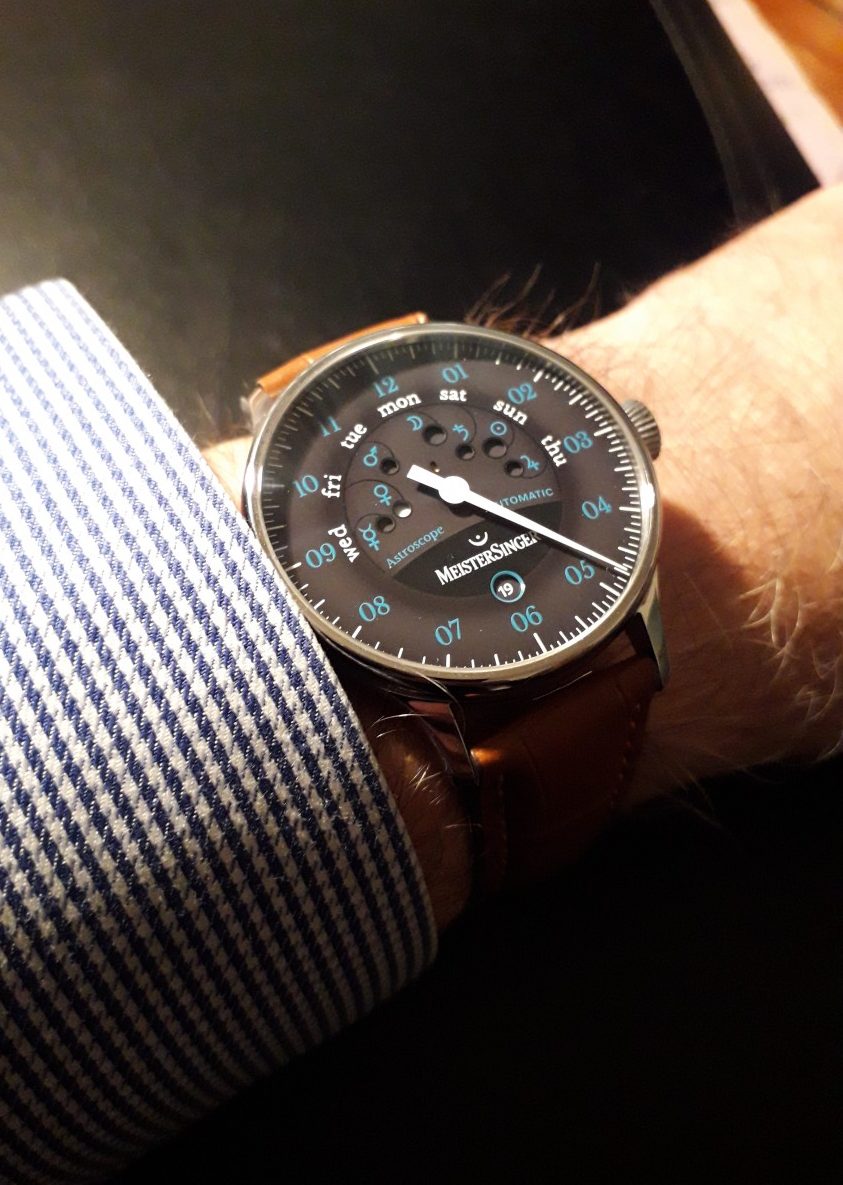
The piece I selected is the Astroscope, and in particular reference AS902B. Why? Well I think it is an attractive time piece which has some interesting complications. The case is stainless steel and 40 mm x 10.5 mm in size, so an easy wearer. It is a round watch, accentuated not only by the comparatively small but nicely shaped lugs, but also the case sides which are quite rounded underneath too. In fact so much so, that the tapering semi-onion crown is supported underneath by a neat and small outcrop moulded into the case. There is a domed sapphire glass atop.
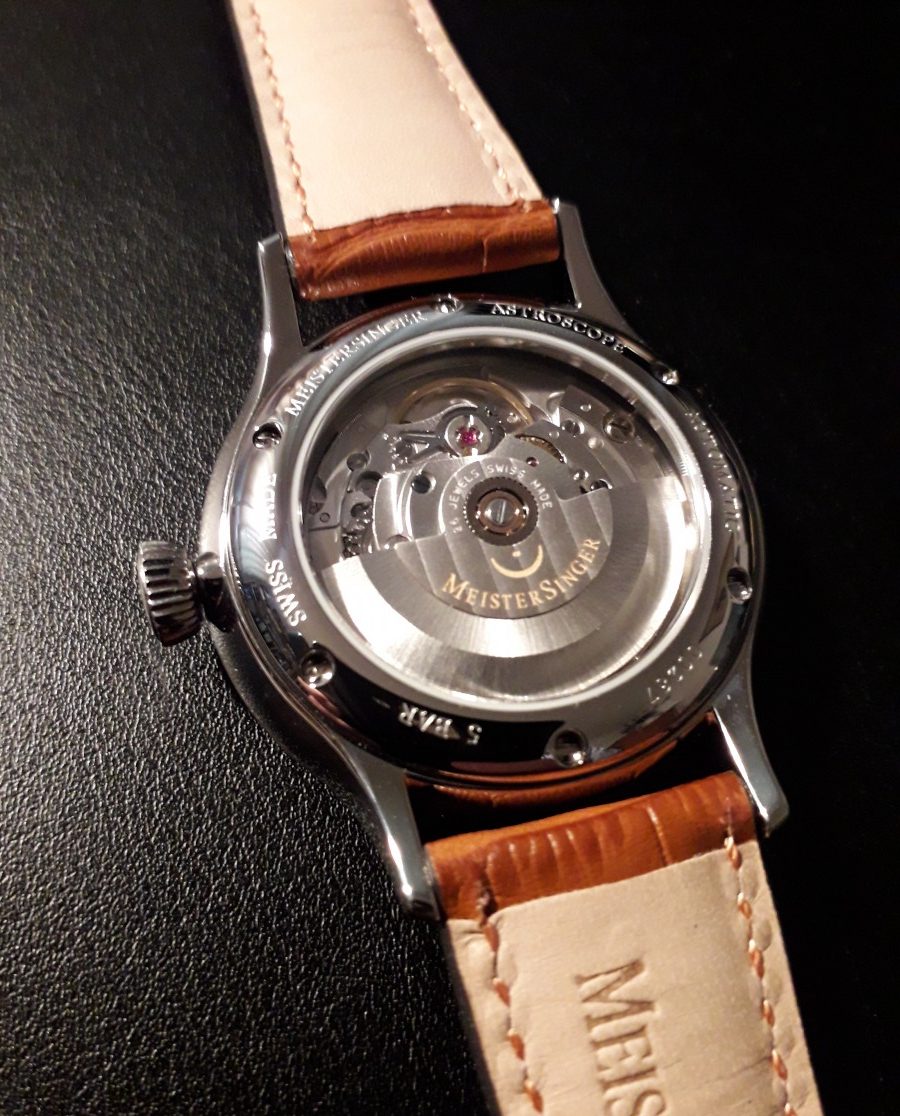
The reverse reveals a very sculptured ring containing an exhibition glass, all held in place by six neat recessed screws. The window reveals the movement (MSH01), which is a modification of the Sellita SW220. This has 26 rubies and offers 38 hrs of power at 4 Hz. The movement is dominated by a large rotor which has the MS name and logo picked out in gold script, plus a combination of brushed sun rays and Cotes de Geneve bands. Most of the underlying plates and bridges have similar decoration, but a loupe is really needed to fully appreciate. This is an unusual and indeed welcome amount of detail on such a movement at the noted price point.
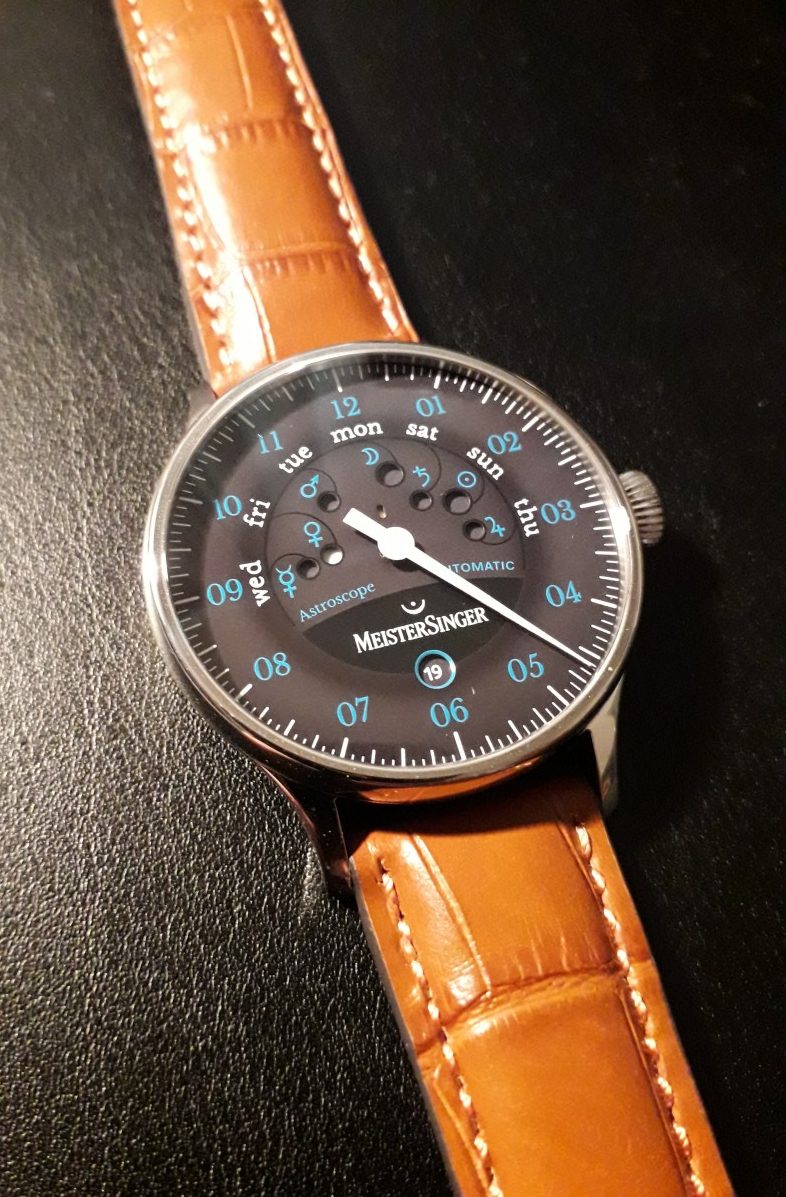
I left the dial to last as this is one of the watch’s main attractions. The underlying dial colour on these models is black, and with much information to digest, I will carefully attempt to impart this from the outside in! Outboard there is a segmented hour and minute track in white. The hour markers are the longest, then followed by the half hours. Smaller still are the quarter hours and then down to the five minute ones. So, there are no minute markers. Next are the hour numerals in Arabic. On this version they are in a jolly turquoise blue but on the two other versions they are in copper (a little orange-like) and old radium (light tan). They simply commence with 01, 02 etc. Inside this, and starting at 9 and upwards, round to 3, the days of the week are noted in white – in no particular order. Inboard and next to these are corresponding celestial symbols which are also connected to the seven main planets (as originally observed) and next, the days. So, in this case, Monday is the Moon and Tuesday Mars and so on. I will not attempt to describe the matter further, or the symbols – just take a look! Whatever, according to MeisterSinger, there is some evidence to suggest an early Babylonian connection. Inboard again, are circular portals that show a white disc to indicate the appropriate day. At 6 is the small and discrete round date window with white numerals. Along with the brands name and logo, plus watch name, there is no denying that the dial is pretty busy.
Finally, lume is applied to the one and only elongated dart/needle type hand, along with the day script and indicators. In the dark it is an appealing sight!
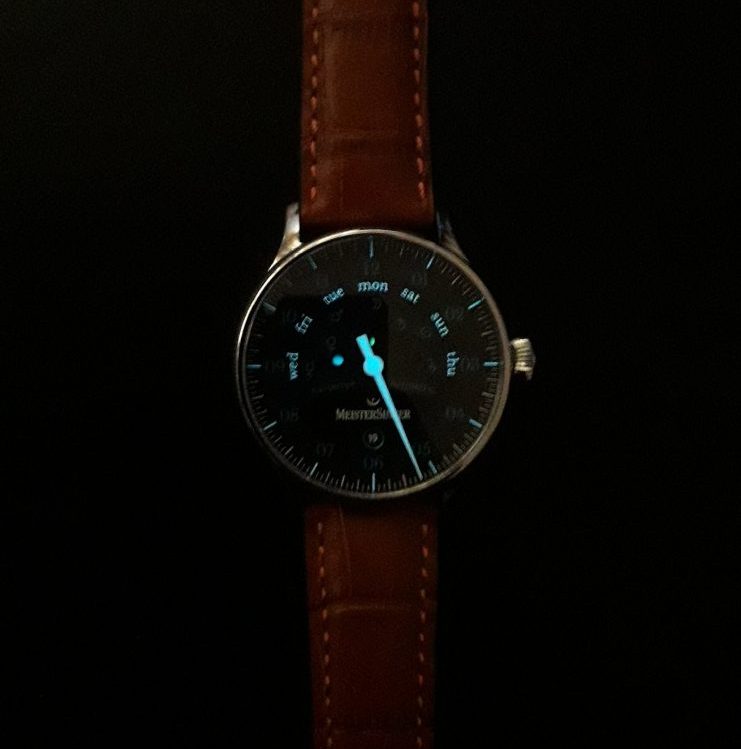
The watch is finished by a calf strap with crocodile pattern in light brown (Cognac) and pin buckle. A vintage saddle leather colour version is available in the same colour and also a Milanese type bracelet.
So, what are my conclusions? Well, the watch is of a good shape/size, and has a decent and reliable movement – albeit a tad workhorse. The power reserve is a bit on the meagre side, however I suppose it does have a few things to move around! The decoration is unexpected but attractive. In this model there are many interesting and novel complication features which are quite clever in action. I did find however that dependent on the light (say at dusk) and watch position, it was sometimes a little less clear to see the items in blue on the black dial. With all that was going on – plus with only the one hand, it made reading a little more effort, but that is but a minor point really. In truth I suppose all-white numerals will always be the clearer option , but, could get a little boring! Personally, I think that some of the brand’s other models with Ivory/white dials (and a bit less less going on), such as the Vintago, Cicularis, No 1, and the lovely limited edition 366, offer the best clarity. I do accept that part of this may be due to the shortcomings of being a middle-aged person only used to two-handers! Lastly, the strap colour/pattern compliments the watch nicely. It is a little on the stiff side (its the padding), but I guess will soften with use. I think all the strap options work well.
At a price of some £1,990, I feel this is, overall, acceptable. You get an attractive watch of decent quality at this price point, along with some fascinating complications, and certainly one-handed individualism. If you are new to these particular watches then you may need to get your head around it first, but then could quite easily enjoy the experience. On balance, yes, a one-handed heavenly body!
Rating: 4/5
Words/Images: The Writer

